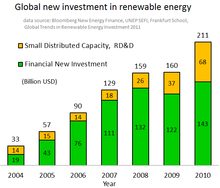From Wikipedia, the free encyclopedia
The resource-based view (RBV)
is a managerial framework used to determine the strategic resources a
firm can exploit to achieve sustainable competitive advantage.
Barney's 1991 article "Firm Resources and Sustained Competitive
Advantage" is widely cited as a pivotal work in the emergence of the
resource-based view. However, some scholars argue that there was evidence for a fragmentary resource-based theory from the 1930s.
RBV proposes that firms are heterogeneous because they possess
heterogeneous resources, meaning firms can have different strategies
because they have different resource mixes.
The RBV focuses managerial attention on the firm's internal
resources in an effort to identify those assets, capabilities and
competencies with the potential to deliver superior competitive
advantages.
Origins and background
During the 1990s, the resource-based view (also known as the resource-advantage theory)
of the firm became the dominant paradigm in strategic planning. RBV
can be seen as a reaction against the positioning school and its
somewhat prescriptive approach which focused managerial attention on
external considerations, notably industry structure.
The so-called positioning school had dominated the discipline
throughout the 1980s. In contrast, the resource-based view argued that
sustainable competitive advantage derives from developing superior
capabilities and resources. Jay Barney's
1991 article, "Firm Resources and Sustained Competitive Advantage," is
seen as pivotal in the emergence of the resource-based view.
A number of scholars point out that a fragmentary resource-based
perspective was evident from the 1930s, noting that Barney was heavily
influenced by Wernerfelt's earlier work which introduced the idea of
resource position barriers being roughly analogous to entry barriers in
the positioning school.
Other scholars suggest that the resource-based view represents a new
paradigm, albeit with roots in "Ricardian and Penrosian economic
theories according to which firms can earn sustainable supranormal
returns if, and only if, they have superior resources and those
resources are protected by some form of isolating mechanism precluding
their diffusion throughout the industry." While its exact influence is debated, Edith Penrose's 1959 book The Theory of the Growth of the Firm
is held by two scholars of strategy to state many concepts that would
later influence the modern, resource-based theory of the firm.
The RBV is an interdisciplinary approach that represents a substantial shift in thinking.
The resource-based view is interdisciplinary in that it was developed
within the disciplines of economics, ethics, law, management, marketing,
supply chain management and general business.
RBV focuses attention on an organisation's internal resources as a
means of organising processes and obtaining a competitive advantage.
Barney stated that for resources to hold potential as sources of
sustainable competitive advantage, they should be valuable, rare,
imperfectly imitable and not substitutable (now generally known as VRIN criteria).
The resource-based view suggests that organisations must develop
unique, firm-specific core competencies that will allow them to
outperform competitors by doing things differently.
Although the literature presents many different ideas around the
concept of the resource-advantage perspective, at its heart, the common
theme is that the firm's resources are financial, legal, human,
organisational, informational and relational; resources are
heterogeneous and imperfectly mobile and that management's key task is
to understand and organise resources for sustainable competitive
advantage. Key theorists who have contributed to the development of a coherent body of literature include Jay B. Barney, George S. Day, Gary Hamel, Shelby D. Hunt, G. Hooley and C.K. Prahalad.
Concept
Achieving
a sustainable competitive advantage lies at the heart of much of the
literature in strategic management and strategic marketing J and
Smithee, A. "Strategic Marketing and the Resource Based View of the
Firm," Journal of the Academy of Marketing Science R The
resource-based view offers strategists a means of evaluating potential
factors that can be deployed to confer a competitive edge. A key insight
arising from the resource-based view is that not all resources are of
equal importance, nor do they possess the potential to become a source
of sustainable competitive advantage. The sustainability of any competitive advantage depends on the extent to which resources can be imitated or substituted.
Barney and others point out that understanding the causal relationship
between the sources of advantage and successful strategies can be very
difficult in practice.
Thus, a great deal of managerial effort must be invested in
identifying, understanding and classifying core competencies. In
addition, management must invest in organisational learning to develop,
nurture and maintain key resources and competencies.
In the resource-based view, strategists select the strategy or
competitive position that best exploits the internal resources and
capabilities relative to external opportunities. Given that strategic
resources represent a complex network of inter-related assets and
capabilities, organisations can adopt many possible competitive
positions. Although scholars debate the precise categories of
competitive positions that are used, there is general agreement, within
the literature, that the resource-based view is much more flexible than
Porter's prescriptive approach to strategy formulation.
The key managerial tasks are:
- Identify the firm's potential key resources.
- Evaluate whether these resources fulfill the following criteria (also known as VRIN criteria:
- Valuable - they enable a firm to implement strategies that improve its efficiency and effectiveness.
- Rare - not available to other competitors.
- Imperfectly imitable - not easily implemented by others.
- Non-substitutable - not able to be replaced by some other non-rare resource.
- Develop, nurture and protect resources that pass these evaluations.
Definitions
Given
the centrality of resources in terms of conferring competitive
advantage, the management and marketing literature carefully defines and
classifies resources and capabilities.
Resources
Barney defines firm resources as: "all assets,
capabilities, organizational processes, firm attributes, information,
knowledge, etc. controlled by a firm that enable the firm to conceive of
and implement strategies that improve its efficiency and effectiveness"
Capabilities
Capabilities
are "a special type of resource, specifically an organizationally
embedded non-transferable firm-specific resource whose purpose is to
improve the productivity of the other resources possessed by the firm."
Competitive advantage
Barney defined a competitive advantage
as "when [a firm] is able to implement a value creating strategy not
simultaneously being implemented by any current or potential
competitors."
Classification of resources and capabilities
Firm-based resources may be tangible or intangible.
- Tangible resources include: physical assets such as
financial resources and human resources including real estate, raw
materials machinery, plant, inventory, brands, patents and trademarks
and cash.
- Intangible resources may be embedded in organisational
routines or practices such as an organization's reputation, culture,
knowledge or know-how, accumulated experience, relationships with
customers, suppliers or other key stakeholders.
They are particularly valuable in resource-based view because they
give companies advantages in using resources. For example, patents make
it impossible for other firms to use their resources in the same way and
brand might be the only thing differentiating the product from the
competitor’s.
Resources and capabilities may also be intraorganizational or interorganizational:
While RBV scholars have traditionally focused on
intraorganizational resources and capabilities, recent research points
to the importance of interorganizational routines. Routines between organizations and the ability to manage interorganizational relationships can improve performance. Such collaboration capabilities are, in particular, supported by contract design capabilities.
An efficient use of contracts in the management of interorganizational
relationships can facilitate the transfer of information, enhance
organizational learning, and help develop relational capital.
The resources are divided into two critical assumptions:
- Heterogeneous: It is the assumption that each company has
different skills, capabilities, structure, resources and that makes
each company different. Due to the different forms of employment and
amount of resources, organizations can design different strategies that
promote competitiveness in the market.
- Immobile: It is the assumption that is based on the resources
that an organization owns are not mobile, in other words, at least in
short terms, cannot be transferred from one company to another.
Companies can hardly obtain the immobile resources of their competitors
since those resources have an important value for companies.
RBV and strategy formulation
Firms in possession of a resource, or mix of resources that are rare among competitors, are said to have a comparative advantage.
This comparative advantage enables firms to produce marketing offerings
that are either (a) perceived as having superior value or (b) can be
produced at lower costs. Therefore, a comparative advantage in resources
can lead to a competitive advantage in market position.
In the resource-based view, strategists select the strategy or
competitive position that best exploits the internal resources and
capabilities relative to external opportunities. Given that strategic
resources represent a complex network of inter-related assets and
capabilities, organisations can adopt many possible competitive
positions. Although scholars debate the precise categories of
competitive positions that are used, there is general agreement, within
the literature, that the resource-based view is much more flexible than
Porter's prescriptive approach to strategy formulation. Hooley et al.
suggest the following classification of competitive positions:
- Price positioning
- Quality positioning
- Innovation positioning
- Service positioning
- Benefit positioning
- Tailored positioning (one-to-one marketing)
Criticisms
A number of criticisms of RBV have been widely cited, and are as follows:
- The RBV is tautological
- Different resource configurations can generate the same value for firms and thus would not be competitive advantage
- The role of product markets is underdeveloped in the argument
- The theory has limited prescriptive implications.
Other criticisms include:
- The failure to consider factors surrounding resources; that is,
an assumption that they simply exist, rather than a critical
investigation of how key capabilities are acquired or developed.
- It is perhaps difficult (if not impossible) to find a resource which satisfies all of Barney's VRIN criteria.
- An assumption that a firm can be profitable in a highly competitive
market as long as it can exploit advantageous resources does not always
hold true. It ignores external factors concerning the industry as a
whole; Porter’s Industry Structure Analysis ought also be considered.








